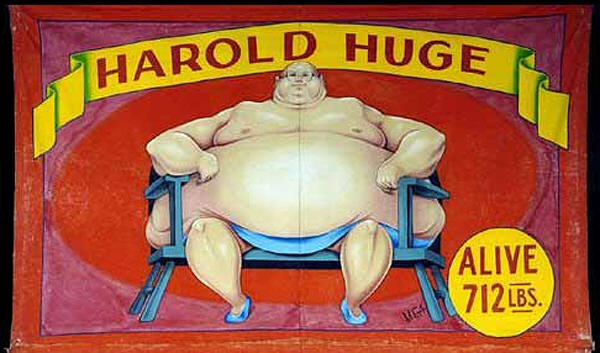I like this post. And it’s the two-year anniversary of Bruce Snowdon’s death. So, here’s my toast to the last sideshow fat man.
He’s so big and so fat it takes four girls to hug him and a box car to lug him. When he dances you’ll swear he must be full of jelly, cause jam don’t shake that way. And you know girls! He is single and lookin’ for a wife, he’ll make some lucky girl a fine husband, why he’s so big and fat, he’ll provide you with a lot of shade in the summertime, keep you nice and warm in the winter time and give you lots of good heavy lovin’ all of the time!
— Carnival Spiel by Ward Hall
On Nov. 9th 2009, Harold Huge, a man billed as the very last sideshow fat man, died. He weighed 607 pounds or so.
Harold’s real name was Bruce Snowdon. He had degrees in paleontology, anthropology and chemistry. In 1977, he found himself bored with his work and stumbled across the idea of being a Fat Man:
I had put on a lot of weight between the time I was 20 and 25. I was up to about 450 in those days. I went to the local library, and I was poking through some old circus books and I see this one picture about a sideshow, maybe circa 1905, and I’m looking at this fat man and I’m saying to myself, “He can’t weigh more than 350 pounds.”
Now, I ask myself, how the hell would I go about getting into a sideshow? I’d never even seen a sideshow in my lifetime. In the late ’70s the industry was a very pale ghost of its former self. Instead of thousands, there were maybe dozens left then. So I figured, logically, there’s got to be some sort of trade journal for the carnival industry. It’s Amusement Business. And I’m looking through the AB. Taking a lucky stab, I wrote the editor, Tom Powell. And Tom Powell happens to be a very good friend of Ward Hall. Bingo. I had the job.
In an interview with James Taylor (from which the above quote is also taken), Snowden explained:
I don’t mind being enormously fat… I come from a long line of fat people. My old man tortured himself for 40 years going from 200 to 300 [pounds] and back again. He eventually lost the weight, but he also lost his mind.
Snowdon played Harold Huge for 26 years. The year of his retirement, in 2003, he played himself in the movie, Big Fish:
So the sociological question I would like to pose is: Why is Snowdon the last fat man?
Marc Hartzman suggests that fat men and woman became less of a curiosity because “waistlines expanded and obesity became less of a laughing matter. As the years went by, spotting a man who weighed more than quarter of a ton was not that unusual…” So there’s two hypotheses: (1) we see fat people everywhere and so it’s no longer a curiosity and (2) obesity has become a very serious matter, not to be played with at sideshows or elsewhere.
Another hypothesis might involve (3) a growing distaste for objectifying and dehumanizing those who are unusual. As the human rights era evolves, we increasingly embrace difference and promote tolerance.
(4) Perhaps sideshows themselves are simply out-of-fashion, a drab alternative to Avatar in 3D or a Wii. Or, (5) maybe the internet has made all curiosity easier to quench. With a click of the button, we can see DD breasts, thalidomide babies, and cats playing the piano… who needs a sideshow?
I can think of reasons to endorse and reject all of these hypotheses.
So, in honor of Snowdon’s 26 years of service and delightful sense of humor (“If there’s a bitchy type of human being, it’s somebody on a diet”), let’s speculate.
Sources: Sideshow World, AOL News, Shocked and Amazed, Randall Levenson photography, and Shapely Prose.
Lisa Wade, PhD is an Associate Professor at Tulane University. She is the author of American Hookup, a book about college sexual culture; a textbook about gender; and a forthcoming introductory text: Terrible Magnificent Sociology. You can follow her on Twitter and Instagram.





















